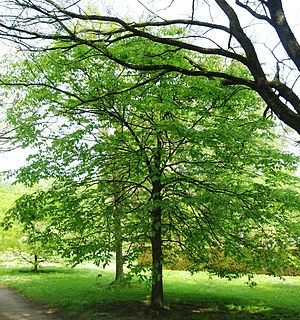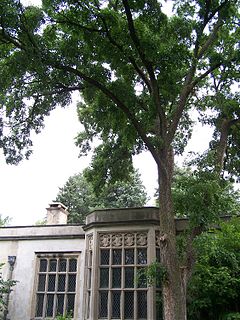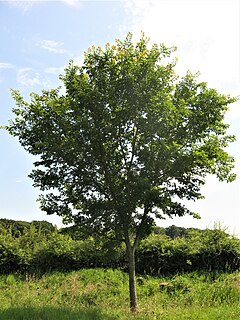Related Research Articles

Ulmus rubra, the slippery elm, is a species of elm native to eastern North America, ranging from southeast North Dakota, east to Maine and southern Quebec, south to northernmost Florida, and west to eastern Texas, where it thrives in moist uplands, although it will also grow in dry, intermediate soils. Other common names include red elm, gray elm, soft elm, moose elm, and Indian elm. The tree was first named as part of Ulmus americana in 1753, but identified as a separate species, Ulmus rubra, in 1793 by Pennsylvania botanist Gotthilf Muhlenberg. The slightly later name U. fulva, published by French botanist André Michaux in 1803, is still widely used in dietary-supplement and alternative-medicine information.

Ulmus thomasii, the rock elm or cork elm, is a deciduous tree native primarily to the Midwestern United States. The tree ranges from southern Ontario and Quebec, south to Tennessee, west to northeastern Kansas, and north to Minnesota.

Ulmus davidiana var. japonica, the Japanese elm, is one of the larger and more graceful Asiatic elms, endemic to much of continental northeast Asia and Japan, where it grows in swamp forest on young alluvial soils, although much of this habitat has now been lost to intensive rice cultivation.
The hybrid elm cultivar Ulmus × intermedia 'Coolshade' is an American hybrid cultivar cloned from a crossing of the Slippery, or Red, Elm Ulmus rubra and the Siberian Elm Ulmus pumila at the Sarcoxie Nurseries, Sarcoxie, Missouri, in 1946. At Arnold Arboretum, where there was a specimen, herbarium material was labelled Ulmus pumila 'Coolshade'.

Ulmus 'Morton' is an elm cultivar cloned from a putative intraspecific hybrid planted at the Morton Arboretum in 1924, which itself originated as seed collected from a tree at the Arnold Arboretum in Massachusetts. Although this tree was originally identified as Ulmus crassifolia, it is now believed to have been a hybrid of the Japanese elm and Wilson's elm. Accolade has proven to be the most successful cultivar tested in the US National Elm Trial, averaging a survival rate of 92.5% overall.

Ulmus 'Morton Glossy' is a hybrid cultivar raised by the Morton Arboretum, Illinois. Originally named 'Charisma' until it was realized that name had already been registered for another plant, the tree was derived from a crossing of two other hybrid cultivars grown at the Morton: Accolade and Vanguard. Tested in the US National Elm Trial coordinated by Colorado State University, Triumph averaged a survival rate of 86% after 10 years. Triumph was introduced to the UK in 2006 by the Frank P. Matthews nursery in Worcestershire.

Ulmus 'Morton Red Tip' is a hybrid cultivar raised by the Morton Arboretum from an open pollination of Ulmus 'Morton'. The tree has occasionally been reported as a hybrid of Accolade with the Siberian Elm Ulmus pumila, an error probably owing to the commercial propagation of the tree by grafting onto U. pumila rootstocks. Tested in the US National Elm Trial coordinated by Colorado State University, Danada Charm averaged a survival rate of 77.5% after 10 years.

Ulmus 'Morton Stalwart', is a Morton Arboretum hybrid cultivar arising from a controlled crossing of Accolade with the hybrid of a Field Elm U. minor from eastern Russia and a Siberian Elm U. pumila. Tested in the US National Elm Trial coordinated by Colorado State University, Commendation averaged a survival rate of 85% after 10 years.
The Siberian elm cultivar Ulmus pumila 'Green King' was once believed to have been derived from a crossing of the Siberian Elm Ulmus pumila with the American Red Elm Ulmus rubra. However, it is now apparent the tree originated as a sport of U. pumila in 1939 at the Neosho Nurseries, Neosho, Missouri.

The American Elm cultivar Ulmus americana 'Delaware' was originally selected from 35,000 seedlings inoculated with the Dutch elm disease fungus in USDA trials at Morristown, New Jersey.

The elm cultivar Ulmus 'Purpurea', the purple-leaved elm, was listed and described as Ulmus Stricta Purpurea, the 'Upright Purpled-leaved Elm', by John Frederick Wood, F.H.S., in The Midland Florist and Suburban Horticulturist (1851), as Ulmus purpureaHort. by Wesmael (1863), and as Ulmus campestris var. purpurea, syn. Ulmus purpureaHort. by Petzold and Kirchner in Arboretum Muscaviense (1864). Koch's description followed (1872), the various descriptions appearing to tally. Henry (1913) noted that the Ulmus campestris var. purpureaPetz. & Kirchn. grown at Kew as U. montana var. purpurea was "probably of hybrid origin", Ulmus montana being used at the time both for wych elm cultivars and for some of the U. × hollandica group. His description of Kew's U. montana var. purpurea matches that of the commonly-planted 'Purpurea' of the 20th century. His discussion of it (1913) under U. campestris, however, his name for English Elm, may be the reason why 'Purpurea' is sometimes erroneously called U. procera 'Purpurea' (as in USA and Sweden.

The Siberian elm cultivar Ulmus pumila 'Hansen' is a little-known American tree of obscure origin, possibly raised from seed collected by the horticulturist and botanist Prof. Niels Hansen during his expedition to Siberia in 1897.

The dwarf wych elm cultivar Ulmus glabra 'Nana', a very slow growing shrub that with time forms a small tree, is of unknown origin. It was listed in the Simon-Louis 1869 catalogue as Ulmus montana nana. Henry (1913), referring his readers to an account of the Kew specimen in the journal Woods and Forests, 1884, suggested that it may have originated from a witch's broom. It is usually classified as a form of Ulmus glabra and is known widely as the 'Dwarf Wych Elm'. However, the ancestry of 'Nana' has been disputed in more recent years, Melville considering the specimen once grown at Kew to have been a cultivar of Ulmus × hollandica.
The hybrid elm cultivar Ulmus × hollandica 'Ypreau' is one of a number of cultivars arising from the crossing of the Wych Elm U. glabra with a variety of Field Elm U. minor. The tree was first identified by Poederlé in Manuel De L'Arboriste Et Du Forestier Belgiques 266, 1772, as l'orme Ypreau.
The hybrid elm cultivar Ulmus 'Hamburg' was originally raised by the Plumfield Nurseries, Fremont, Nebraska, circa 1932, after its discovery by Mr. Lloyd Moffet in a bed of Siberian Elm Ulmus pumila seedlings from Tekamah. It was later marketed by Interstate Nurseries, Hamburg, Iowa, in 1948, and claimed to be a hybrid of Ulmus pumila and Ulmus americana. However it is now considered more likely that Ulmus rubra was the male parent.
The hybrid elm cultivar Ulmus × intermedia 'Rosehill' is an American hybrid cultivar originally raised by the Rose Hill Nurseries of Kansas City, Missouri, from a selection of Ulmus pumila × Ulmus rubra seedlings made in 1951.
The hybrid elm cultivar Ulmus × intermedia 'Willis' originated as a crossing made by a Mr Minnick of Kansas. Almost certainly derived from a crossing of the Siberian Elm Ulmus pumila and the Red Elm Ulmus rubra, it was originally believed that the male parent was the American Elm Ulmus americana.

The hybrid cultivar Ulmus 'Androssowii'R. Kam., an elm of Uzbekistan sometimes referred to in old travel books as 'Turkestan Elm' or as 'karagach' [:black tree, = elm], its local name, is probably an artificial hybrid. According to Lozina-Lozinskaia the tree is unknown in the wild in Uzbekistan, and apparently arose from a crossing of U. densa var. bubyrianaLitv., which it resembles, and the Siberian Elm Ulmus pumila.
The Chinese Elm cultivar Ulmus parvifolia 'Garden City Clone' was raised in Kansas. The champion tree was 18 m tall in 1993; however, the name 'Garden City Clone' is not officially recognized.

The wych elm cultivar Ulmus glabraHuds. 'Superba', Blandford Elm, with unusually large leaves, was raised by Gill's of Blandford Forum, Dorset, in the early 1840s as Ulmus montana superba and was quickly distributed to other UK nurseries. It was confirmed as a form of wych, and first described, by Lindley in The Gardeners' Chronicle, 1845, later descriptions being added by Gill (1845) and Morren (1848), who called it U. montana var. superba. Morren had adopted the name 'Superba' from the Fulham nurseryman Osborne in 1844, who supplied him with the tree – presumably one of the nurseries supplied by Gill. Morren states that 'Superba', already in cultivation in England, was introduced to Belgium by Denis Henrard of Saint Walburge, Liège, that in 1848 it had been present in Belgium for only three years, and that this variety was the one described as 'Superba' by Osborne, whom Henrard had visited at his nursery in Fulham in September 1844. 'Blandford Elm', with leaves of the same dimensions, was soon for sale in the USA.
References
- ↑ Santamour, Frank S.; Bentz, Susan E. (May 1995). "Updated Checklist of Elm (Ulmus) Cultivars for use in North America". Journal of Arboriculture. 21 (3): 122–131. Retrieved 20 June 2016.
- ↑ Green, Peter Shaw (1964). "Registration of cultivar names in Ulmus". Arnoldia. Arnold Arboretum, Harvard University. 24 (6–8): 41–80. Retrieved 16 February 2017.